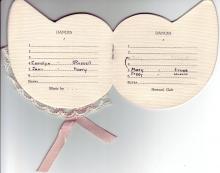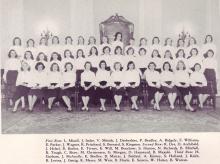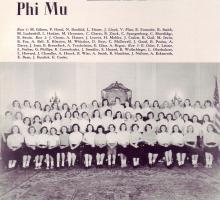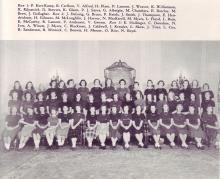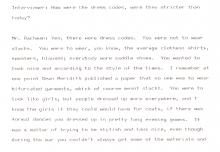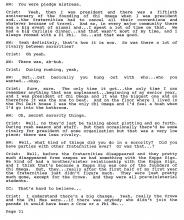Pan-Hellenic Council in 1952
In 1952 the Pan-Hellenic Council was lead by Phyllis M. Lamont, president, and Marjorie E. Heymann, secretary-treasurer, and was composed of two members of each of the four sororities on campus. In addition to organizing the two weeks of fall rush, Pan-Hellenic focused on organizing the all-college Doll Dance before the winter recess. To enter the Doll Dance, participants had to bring a doll to donate to the children of prisoners; attendees were entertained by skits presented by the new pledge classes.
Role of Sororities during World War II
In an interview, Helen Alexander Bachman (Class of 1946) claims that a majority of the students belonged to a sorority, fraternity, or other organization on campus. Bachman estimates that 99 percent of female students belonged to one of the four sororities. The fraternities owned houses while sorority women had apartments in Carlisle. Fraternities "dried up" during the war due to the absence of men. Sororities, however, had meetings, social functions, bridge parties, suppers, and community service events.
Social Events during World War II
Helen Alexander Bachman (Class of 1946) describes social events during World War II in a 1990 interview. Dickinson College had sororities and fraternities, which planned pledge dances and parties. As a Zeta Tau alpha, Bachman remembers using the fraternity houses for sorority pledge dances. Professors and their wives would chaperone dances and other student activities. When male students were drafted into the army, it affected the social life on campus. Female students went to the movies, played bridge, or went to dinner.
Student conduct and dress codes during World War II
In an interview with Helen Alexander Bachman (Class of 1946), the Dickinson alumnus describes the rules for student conduct and dress codes during the World War II period. Dean Josephine Meredith supervised the women, requiring them to sign in and out of their dorms, to act in a lady-like manner, and to avoid drinking. Moreover, female students needed to receive signed permission from parents if they wanted to visit home for the weekend. Bachman explains that these rules "existed to protect the girls...." Dress codes for the female students were strict; they coudl not wear slacks.
Rivalry among sororities during World War II
Christine Crist (Class of 1946) tells about the rivalry among sororities during the World War II period. As a pledge mistress and, later, president of Chi Omega, she spent a lot of her free time planning sorority events. She organized an alumni event for the 50th anniversary of the founding of Chi Omega.

